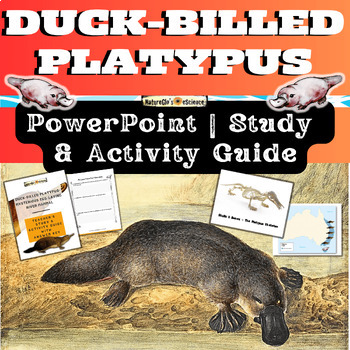Platypus PowerPoint with Activity and Study Guide
Natureglo's eScience
147 Followers
Grade Levels
3rd - 8th, Homeschool
Subjects
Resource Type
Standards
CCSSRL.5.1
CCSSRL.5.4
CCSSRL.5.5
CCSSRL.5.7
CCSSRL.8.1
Formats Included
- Zip
- Internet Activities
Pages
70 pages
Natureglo's eScience
147 Followers
Compatible with Digital Devices
The Teacher-Author has indicated that this resource can be used for device-based learning.
Description
Get ready to explore the world of the Duck-billed platypus, one of the most bizarre and mysterious mammals in the world from eastern Australia and Tasmania. Platypus facts include that they sport a tail like a beaver, bill and feet like a duck, and lay eggs like a bird! Platypuses give birth to furless babies called puggles.
What's Included:
- One Quick Start Guide
- One 23-slide animated PowerPoint (both PPTX and PDF file types)
- One 20-page fillable student activity and study guide
- One 26-page EDITABLE teacher/parent activity and study guide (answer key included)
- One set of Research Project Templates
- One Research Project Scoring Rubric
Topics Covered:
- Geographic range
- History and discovery
- Characteristics
- Etymology (word meaning)
- Diet
- Platypus habitat
- Platypus life cycle
- Platypus nest
- Platypus swimming
- Platypus skeleton
- Platypus Venom
Total Pages
70 pages
Answer Key
Included
Teaching Duration
90 minutes
Report this resource to TPT
Reported resources will be reviewed by our team. Report this resource to let us know if this resource violates TPT’s content guidelines.
Standards
to see state-specific standards (only available in the US).
CCSSRL.5.1
Quote accurately from a text when explaining what the text says explicitly and when drawing inferences from the text.
CCSSRL.5.4
Determine the meaning of words and phrases as they are used in a text, including figurative language such as metaphors and similes.
CCSSRL.5.5
Explain how a series of chapters, scenes, or stanzas fits together to provide the overall structure of a particular story, drama, or poem.
CCSSRL.5.7
Analyze how visual and multimedia elements contribute to the meaning, tone, or beauty of a text (e.g., graphic novel, multimedia presentation of fiction, folktale, myth, poem).
CCSSRL.8.1
Cite the textual evidence that most strongly supports an analysis of what the text says explicitly as well as inferences drawn from the text.





